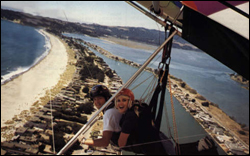"The constant pursuit of perfection in flying, which is of course never
achievable, but it's the pursuit of perfection that brings the greatest rewards,"
says Bodhi Kroll.
He owns a hang-gliding center in San Francisco.
"I've been dreaming about hang-gliding since I was six," says Kroll. He
started hang-gliding in 1984 and became an instructor in 1989 while he studied
at university in California.
"At the time, I viewed it as a 'college job,' not a serious career."
He realized hang-gliding could be a serious career choice when he went
to Australia as an exchange student. Kroll ended up with a dream job as a
tandem instructor.
"I began to realize there was such a worldwide instructor shortage that
I could work anywhere in the world, make good money, and have work that is
so much fun that you can't imagine."
He advises anyone interested in this field to find a certified hang-gliding
school through the USHGA (United States Hang-Gliding Association). "If you
find that you excel, go through an apprenticeship where they teach you to
become an instructor," says Kroll.
Karen Keller teaches hang-gliding part time. "I started flying hang-gliders
in 1978," she says. "I saw a hang-glider on TV and it was beautiful. I had
always dreamed of flying, but like a bird or like Superman."
She tried a sailplane, but she really wanted to be prone and out in the
wind like a bird. She also gave paragliding a try, but hang-gliding was what
she was looking for.
She enjoys introducing others to this exhilarating sport. "To see a student
do well and to gain that self-confidence is great. We are usually yelling
and hugging when a good flight is had."
She says the reward is when the student enjoys the experience.
"When someone has flown, they see life differently. They start to watch
the soaring birds. They look at hills as hang-gliding sites. They watch the
wind and the clouds. It opens up the world around them," she says.
Keller is most proud of one of her current students. Although he had problems
getting into the air, his determination to fly made his dream possible.
"At every obstacle, he tried harder and step by step mastered every one,"
she says. It wasn't until his fourth day of training that everything finally
clicked. He flew perfectly and had a great landing.
"He was so excited. We yelled and laughed and hugged. I would bet my life
that he is now addicted to hang-gliding -- a great feeling for both of us."
Fred Burns is a retired NASA engineer who started hang-gliding many years
ago. "I used to be a big boat sailor," he says. "My son was flying, and he
taught me to fly."
Later, Burns became an instructor. "I do it on the weekends, and I enjoy
it very much." So far, he has taught over a thousand students to hang-glide.
Safety is a priority when Burns is teaching, and he lets his students know.
"I make that very clear to them. If the weather conditions aren't right, we
do it another day."
He says most accidents are simply caused by carelessness. "They fly near
thunderstorms and don't pay attention to the weather."
Burns says he enjoys the teaching aspect of hang-gliding. "Watching a youngster
come along, grab a hold of the sport and go on with it."
 |
| Hang-gliding instructors like Bodhi Kroll teach people to soar like
a bird. Here, Kroll and his wife Hayley are enjoying the view. |
| Courtesy of: Bodhi Kroll |
He says you can tell people what it's like to hang-glide, but you can't
describe it. Imagine flying like a bird over the air! Imagine total freedom!
"The feeling you get is unbelievable. Especially when you get a wonder
wind, which is very buoyant and smooth."
Barry Morwick owns a hang-gliding company. He has been interested in flying
since he bought his first motorized model airplane at the age of 10.
Morwick has always had the desire to fly and even thought about getting
his pilot's license. But he didn't pursue it after he found hang-gliding.
"I have flown my hang-glider all over the world, including some very incredible
flights: launching off a volcano in Maui, Hawaii; climbing to 18,000 feet
of altitude in Telluride, Colorado; and flying four hours over 83 miles last
year right here!"
Morwick truly enjoys his job as a hang-gliding instructor. "With each student
I teach, I relive the excitement of my first flights. I know
that what I am teaching them will change their life."
He says one of the biggest challenges is to convince people in North America
to try hang-gliding, because a lot of people assume it's still dangerous like
it was in the '70s.
"It's different in Europe, where it is said that in some countries as much
as 10 per cent of their population flies some type of sport aircraft, and
hang-gliding is accepted by the public as being safer to do than driving a
car!"